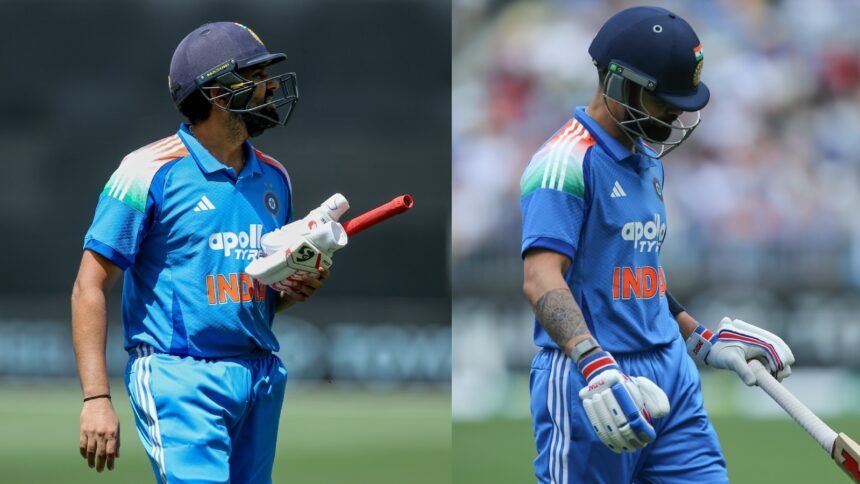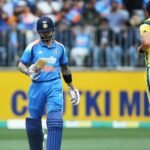Nowhere else in the world does getting out feel as embarrassing as at the Optus. The closed, bowl-like structure traps the noise of the fans; two giant on-field screens, the largest in the Southern Hemisphere, repeat the sequence on a loop. A thousand, smaller television sets inside the arena relay the moments of batsmen’s disappointment to the audience. Batsmen would feel as though it’s a post mortem by thousands of eyes. The agony of losing one’s wicket is not enough; the long trudge to the dressing room is a worse ordeal.
Several of India’s batsmen endured the crushing pain on Sunday. The top-four mustered only 29 runs off 64 -balls in a total of 136/9 in 26 overs; Australia surpassed the DLS-adjusted total of 131 with seven wickets in hand and 29 balls to spare.
The conditions were arduous, even more so for a group that landed in a different hemisphere only three nights ago. The ball zipped off the surface, bounced and seamed. The new Kookaburra swung generously. Rusty limbs and jet-lagged eyes searched furtively for answers that they never found, as Mitchell Starc and Josh Hazlewood mercilessly laid bare their vulnerabilities.
VIRAT KOHLI GONE FOR A DUCK!#AUSvIND pic.twitter.com/cg9GbcMRAE
— cricket.com.au (@cricketcomau) October 19, 2025
It was a classical first-day horror show, made to look worse by the lack of warm-ups and practice games. Rohit Sharma and Virat Kohli last featured in a competitive game in early June; Shubman Gill’s recent outings came in T20s on the modestly-bouncy surfaces in the Emirates; in his most recent outings, List A games Australia A in Kanpur, Shreyas Iyer was dealing with deliveries rising up to his knees.
So the travails were imminent. Worrying, though, was how their old and storied weaknesses were exposed, without Australia’s bowlers needing to put on spectacular shifts.
It didn’t take long for India’s batsmen to comprehend the devils that they would countenance. Rohit negotiated the first four balls with caution. But the fourth one he faced, from Starc, was full and shaped back in. Rohit, assuming it was the Wankhede, swiped across the line and was conclusively beaten. He soon missed another nip-backer from Starc. The repartee was an airy slash that narrowly eluded the fielder at point.
The high-risk approach he wields in the subcontinent was turning counter-productive, but he was in no mood to surrender. A sumptuously pushed four through mid-off brought him four runs, soothing nerves. But he was still fidgety and decided to take on Hazlewood, so often classified as a line-and-length metronome, but whose craft is more nuanced and varied.
Rohit shuffled across and tried to hook him and failed. Hazlewood was largely targeting his body, and Rohit perhaps had his eyes veering to the leg-side.
Story continues below this ad
But Hazlewood is a disguise artist. He can seamlessly shift lines and length. The next ball angled into his off-stump or thereabouts, at a fuller length, luring Rohit into the prod, before seaming away and bouncing awkwardly to graze the top off the bat. Rohit blew his cheeks in disappointment.
Double trouble
Shortly, his pal-in-distress Kohli too joined him in the dressing room, the cheer that greeted him to the middle replaced by reconciled shudder when he walked back after eight tortured balls. The first five were largely on his body, which he dealt with without much fuss, even though the timing was off kilter. The sixth ripped open his tragic flaw outside the off-stump. He chased a full, fast and wide ball from Starc and missed.
He cursed himself. But he could not resist the next time Starc hung one outside the off-stump. The ball was on a good length rather than full and bounced more than Kohli had judged. Still, Kohli slashed, almost impulsively more than drove with just his hands, and Cooper Connolly acrobatically latched onto the thick edge.
You simply cannot miss this! @klrahul is launching some Diwali rockets at the Optus Stadium. 🎇#AUSvIND 👉 1st ODI | LIVE NOW 👉 https://t.co/FkZ5L4CrRl pic.twitter.com/zdv6if5KYK
— Star Sports (@StarSportsIndia) October 19, 2025
Exactly two overs later, before the first rain interruption, Gill too floundered, tickling one off his hips. It’s convenient to shrug it off as unfortunate, but it was not, as Gill was caught in a self-woven tangle. The extra bounce had rendered his movements tentative. He comfortably dealt with full balls, crunching a couple of delightful fours too, but the short ball harried him. He didn’t look particularly frazzled, but felt shackled. On one instance, he shaped for the pull and spun away from the ball because the Hazlewood delivery bounced fiendishly. Perhaps that played in his mind when he tried to glide the short ball from Nathan Ellis past the wicketkeeper.
At 25/3, Shreyas had to show restraint. He did to an extent but the second rain interruption, longer than the first, and the slashing of overs meant he had to be more assertive after resumption. He took on the challenge and cut a rare loosener from Hazlewood through point. But he could only feather an edge to the wicketkeeper when he delivered a short ball into his body. Shreyas found himself in an awful tangle, was confused whether to leave, tuck or defend the ball. His short-ball failings continued.
Story continues below this ad
It took enterprising 30s from KL Rahul and Axar Patel to prop up the total to the realm of respectability.
Future tense
In days to come, with more practice sessions, India’s batsmen would doubtlessly get more acquainted with the conditions. But Rohit and Kohli would feel the four days before the next game, in Adelaide, lengthy. Their spots under pressure, every failure would be viewed as a step closer to the exit door. There could yet be one final flourish in the autumn of their career, but whether they could have the capacity to start performing in an international game or tournament with little practice is uncertain. Both have retired from the other two formats, and barely play domestic tournaments. It’s just the IPL and ODIs, as opposed to what the likes of Yashasvi Jaiswal or Abhishek Sharma would do. So their critics contend that they could make way for youngsters who are at least in the groove.
In the conditions at Optus, Jaiswal or Abhishek or anyone could have struggled, but there could be a wider sense of purpose. That is, they could learn from their mistakes. Even failures are an investment.
It is not the case of just Kohli and Rohit, 37 and 38. The situation would recur, as most teams rarely engage in long bilateral ODI series, and triangular or quadrangular tournaments are near-extinct, forcing Kohli and Rohit to plug and play. Their longevity would depend on whether they could instantly hit their groove. On Sunday, they could not, and the large screens at Optus soaked every second of their agony.








